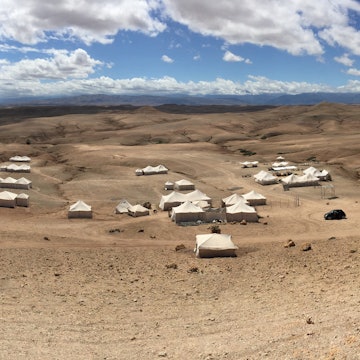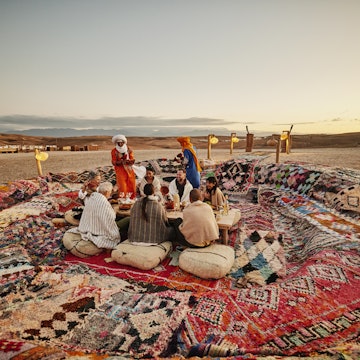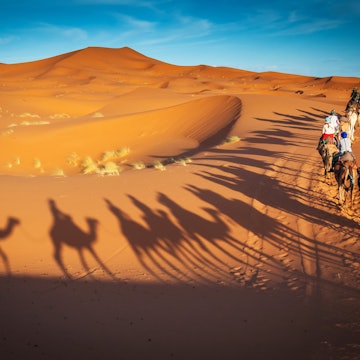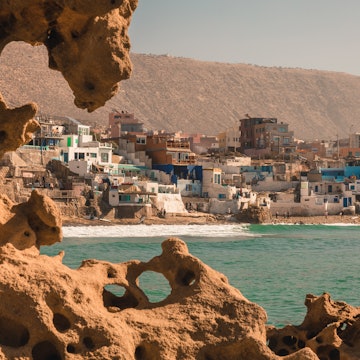

The Dadès Gorge Valley in Morocco. Amanda Cogan Barber/Shutterstock
The epic landscapes of Morocco, from its wild Atlantic coastline to the sweeping Saharan desert and rugged mountains, make it prime road trip territory.
While traversing the country on four wheels can be a nerve-jangling experience – from bumper-to-bumper city traffic to vertiginous mountain passes and unpredictable drivers everywhere – nothing beats the freedom of the open road and exploring at your own pace. Here are our top picks for road-tripping around Morocco.
1. The Dadès Gorge
Best for scenic views
Start/Finish: Skoura – Dadès Gorge
Approximate distance: 117km (73 miles)
The drive through the Dadès Gorge is one of the most scenic in Morocco, with its eye-catching rock formations, earthen Imazighen (Berber) villages, and crumbling kasbahs. This trip should run about 2 hours without stops.
Head east from the palm-fringed oasis town of Skoura, stopping to explore the ancient Glaoui kasbah in the village of Aït Youl. Looming over the road, the ochre fortress has an unexpectedly lush backdrop of fig and almond trees. You can pick up some rose-related products as you pass through Kalaat M’Gouna, which hosts the fragrant Rose Festival in May.
From Boumalne Dadès, follow the gorge’s twists and turns. Soon you’ll spot the Monkey’s Fingers rising from the parched river bed – an otherworldly sandstone cliff sculpted by time and the elements. To the north, the gorge narrows, and the road rises in a series of hair-raising hairpin bends. Take a mint tea break on the terrace of the Hotel Restaurant Timzzillite for stellar views over the serpentine road before heading back down.
Planning tip: Spend the night at the Auberge Chez Pierre built into the gorge and indulge in a fine Morocco-meets-Mediterranean feast at its justly popular restaurant.

2. Marrakesh to Essaouira
Best road trip for families
Start/Finish: Marrakesh – Essaouira 191km (118 miles)
Approximate distance: 191km (118 miles)
En route, where you'll be for about 3 hours, watch out for tree-climbing goats perched on the branches of argan trees (photo ops usually come with a price tag) and argan oil products from women’s cooperatives. Around 30km (19 miles) before Essaouira, Bbio Organic Farm makes the perfect family-friendly pit stop. You’ll be shown their ingenious farming techniques, before a leisurely alfresco lunch of homemade bread, fresh juices and seasonal salads dressed in hand-pressed olive oil (book in advance).
Planning tip: If you’re traveling on a Sunday, it’s worth turning off around 23km (14 miles) from Essaouira to the rural souq at Had Draa, where you’ll find locals haggling over everything from a bleating goat to a plastic bucket.

3. Tizi N’Test Pass
Best for thrill seekers
Start/Finish: Marrakesh – Taroudant
Approximate distance: 230km (143 miles)
The Tizi n’Test is one of the most beautiful, and most dangerous, drives in Morocco. An impressive feat of French engineering, this High Atlas pass reaches a vertigo-inducing 2100m (6890ft). It’s not for the fainthearted – only one-car wide in places, there are precipitous drops aplenty, and local drivers often barrel around blind bends at speed. But take your eyes off the road for an instant – preferably at a roadside cafe – and the views will take your breath away. The trip is around 5 hours with no stops (the pass itself is 49km/30 miles long and takes around 75–90 minutes).
Make your first stop on the scenic R203 (the A3 is a newer, faster, and tamer route to the Souss Valley and Agadir) in the pretty Ouirgane Valley, where you could while away a few days hiking and cycling, or just relax at Ouirgane Ecolodge. Then follow the sinuous road to the architectural wonder of the 12th-century Tin Mal Mosque, 18km (11 miles) from Mouldikht and the start of the pass.
The road winds down to Taroudant, framed by the peaks of the Anti Atlas and High Atlas and dubbed "mini Marrakesh" for its imposing honey-colored ramparts. While there aren’t any must-see sights, its unhurried pace and lack of tourists make it an easy place to linger.
Planning tip: High mountain passes can be closed due to snow from November to March, so check before you set off. Either ask locally or check the weather apps for the Tizi n'Test Pass.

4. Tangier to Chefchaouen
Best for culture vultures
Start/Finish: Tangier – Chefchaouen
Approximate distance: 128km (80 miles)
Tangier, long a haven for artists, writers, and rock stars, is having a revival. After years of neglect, its historic buildings are being restored and new ones are being built. When you’ve explored the stylish shops, galleries, and restaurants that are popping up around this legendary port city, head south on the N2 towards the Rif Mountains and a slower pace of life. (Total trip time is around 3 hours with no stops.)
At the foot of the Rif, the age-old and often-overlooked town of Tetouan still has a Spanish vibe, with its white architecture and stately squares. It’s home to the renowned Royal Artisan School, and you can discover its rich cultural heritage and the work of its master crafters on a half-day tour with Green Olive Arts. From Tetouan, the road rises through dramatic mountain scenery studded with giant oak and cedar trees, passing Riffian villages where traditional dress is still worn, including the distinctive reed hats complete with pom-poms. Chilled-out Chefchaouen, a once-isolated outpost, is famed for its blue-washed medina – take time out from snapping photos to trek the trails of Talassemtane National Park.

5. Tizi n’Tichka Pass
Best road trip for city to desert
Start/Finish: Marrakesh – Ouarzazate
Approximate distance: 193km (120 miles)
One of Morocco’s most dramatic drives is roughly halfway between Marrakesh and Ouarzazate. The Tizi n’Tichka pass reaches the heady heights of 2260m (7415ft). It's a less challenging drive than the Tizi n'Test through a harsh but no less spectacular landscape. Prepare to enjoy the scenery for about 4 hours with no stops.
The road climbs steeply after Ait Ourir, with panoramic views over the snow-dusted Atlas mountains around every switchback turn – try to travel in the morning to avoid distracting truck traffic. Follow the road winding downhill and watch the landscape become more barren as you head toward the southern oases.
You might recognize the Unesco-listed ksar (fortified village) of Ait Ben Haddou – 30km (19 miles) from Ouarzazate – from its starring roles in blockbuster films such as Gladiator (2000) and Lawrence of Arabia (1962), and in Ouarzazate (aka Morocco’s Hollywood), movie buffs can enjoy the Atlas Studios tour.
Detour: From Ouarzazate, follow the N9 southeast through the remote oasis outposts of the Draa Valley to M’Hamid on the fringes of the Sahara, where you can climb aboard a camel – or drive – to a desert camp among the dunes of Erg Chigaga.
Tips for driving in Morocco
Most international rental car companies have outlets at international airports, major cities and popular tourist destinations – take along your driving license, passport and credit card to cover the company’s excess charges. Remember to check the rental agreement’s small print and be clear on what your insurance covers.
A 2WD will get you most places, but if you’re planning some serious off-roading, opt for a 4WD and check that it comes with a functional spare tire.
Download an offline map before you set off as phone signals are scarce in more remote regions.
Avoid driving after dark – thanks to poor road conditions, inclement weather or just stopping to explore, journeys will often take longer than you think.
On the road, keep numbers for emergency services to hand in case of breakdowns, and drive slowly – speed limits are strictly enforced – and defensively.
Keep your papers to hand for any dealings with the police. There’s no legal drunk-driving limit, so drivers should strictly abstain.















